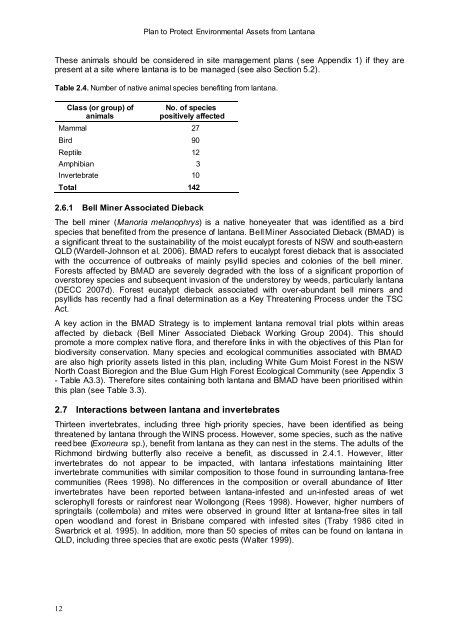Plan to Protect Environmental Assets from Lantana - Weeds Australia
Plan to Protect Environmental Assets from Lantana - Weeds Australia
Plan to Protect Environmental Assets from Lantana - Weeds Australia
Create successful ePaper yourself
Turn your PDF publications into a flip-book with our unique Google optimized e-Paper software.
<strong>Plan</strong> <strong>to</strong> <strong>Protect</strong> <strong>Environmental</strong> <strong>Assets</strong> <strong>from</strong> <strong>Lantana</strong><br />
These animals should be considered in site management plans ( see Appendix 1) if they are<br />
present at a site where lantana is <strong>to</strong> be managed (see also Section 5.2).<br />
Table 2.4. Number of native animal species benefiting <strong>from</strong> lantana.<br />
Class (or group) of<br />
animals<br />
No. of species<br />
positively affected<br />
Mammal 27<br />
Bird 90<br />
Reptile 12<br />
Amphibian 3<br />
Invertebrate 10<br />
Total 142<br />
2.6.1 Bell Miner Associated Dieback<br />
The bell miner (Manoria melanophrys) is a native honeyeater that was identified as a bird<br />
species that benefited <strong>from</strong> the presence of lantana. BellMiner Associated Dieback (BMAD) is<br />
a significant threat <strong>to</strong> the sustainability of the moist eucalypt forests of NSW and south-eastern<br />
QLD (Wardell-Johnson et al. 2006). BMAD refers <strong>to</strong> eucalypt forest dieback that is associated<br />
with the occurrence of outbreaks of mainly psyllid species and colonies of the bell miner.<br />
Forests affected by BMAD are severely degraded with the loss of a significant proportion of<br />
overs<strong>to</strong>rey species and subsequent invasion of the unders<strong>to</strong>rey by weeds, particularly lantana<br />
(DECC 2007d). Forest eucalypt dieback associated with over-abundant bell miners and<br />
psyllids has recently had a final determination as a Key Threatening Process under the TSC<br />
Act.<br />
A key action in the BMAD Strategy is <strong>to</strong> implement lantana removal trial plots within areas<br />
affected by dieback (Bell Miner Associated Dieback Working Group 2004). This should<br />
promote a more complex native flora, and therefore links in with the objectives of this <strong>Plan</strong> for<br />
biodiversity conservation. Many species and ecological communities associated with BMAD<br />
are also high priority assets listed in this plan, including White Gum Moist Forest in the NSW<br />
North Coast Bioregion and the Blue Gum High Forest Ecological Community (see Appendix 3<br />
- Table A3.3). Therefore sites containing both lantana and BMAD have been prioritised within<br />
this plan (see Table 3.3).<br />
2.7 Interactions between lantana and invertebrates<br />
Thirteen invertebrates, including three high- priority species, have been identified as being<br />
threatened by lantana through the WINS process. However, some species, such as the native<br />
reed bee (Exoneura sp.), benefit <strong>from</strong> lantana as they can nest in the stems. The adults of the<br />
Richmond birdwing butterfly also receive a benefit, as discussed in 2.4.1. However, litter<br />
invertebrates do not appear <strong>to</strong> be impacted, with lantana infestations maintaining litter<br />
invertebrate communities with similar composition <strong>to</strong> those found in surrounding lantana-free<br />
communities (Rees 1998). No differences in the composition or overall abundance of litter<br />
invertebrates have been reported between lantana-infested and un-infested areas of wet<br />
sclerophyll forests or rainforest near Wollongong (Rees 1998). However, higher numbers of<br />
springtails (collembola) and mites were observed in ground litter at lantana-free sites in tall<br />
open woodland and forest in Brisbane compared with infested sites (Traby 1986 cited in<br />
Swarbrick et al. 1995). In addition, more than 50 species of mites can be found on lantana in<br />
QLD, including three species that are exotic pests (Walter 1999).<br />
12

















